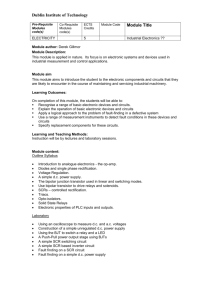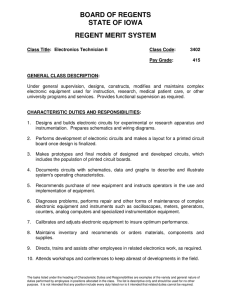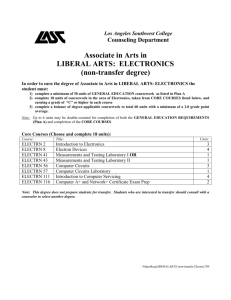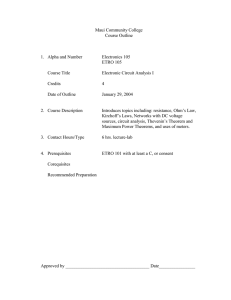Chabot College Fall 2003 Course Outline for Electronics and Computer Technology 60
advertisement
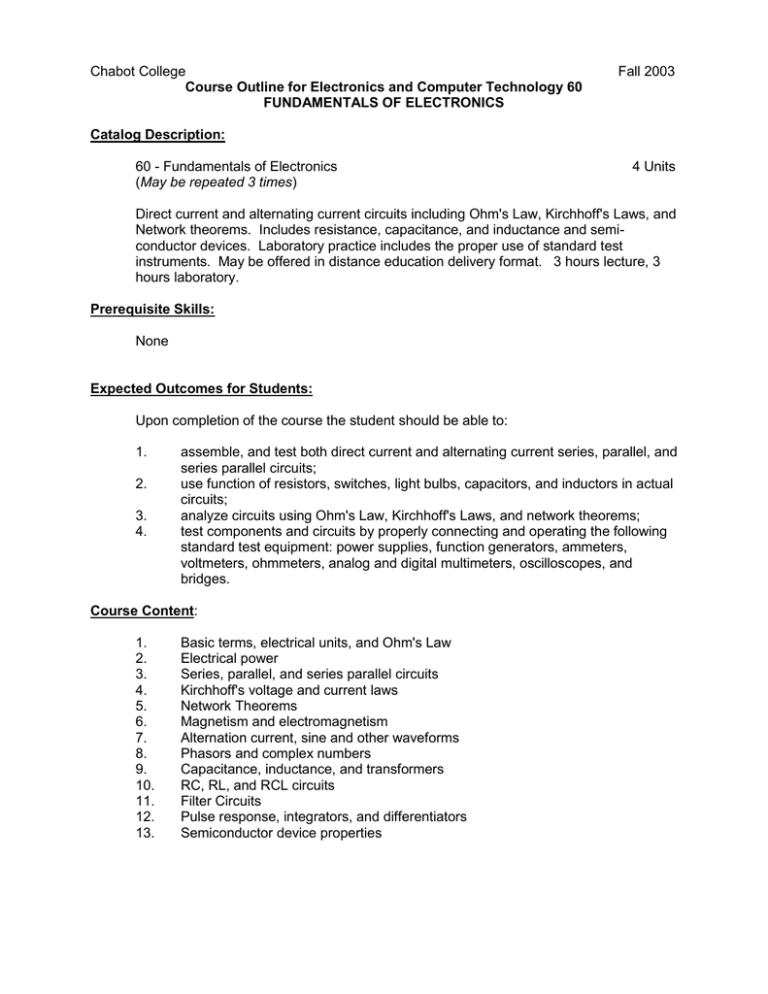
Chabot College Course Outline for Electronics and Computer Technology 60 FUNDAMENTALS OF ELECTRONICS Fall 2003 Catalog Description: 60 - Fundamentals of Electronics (May be repeated 3 times) 4 Units Direct current and alternating current circuits including Ohm's Law, Kirchhoff's Laws, and Network theorems. Includes resistance, capacitance, and inductance and semiconductor devices. Laboratory practice includes the proper use of standard test instruments. May be offered in distance education delivery format. 3 hours lecture, 3 hours laboratory. Prerequisite Skills: None Expected Outcomes for Students: Upon completion of the course the student should be able to: 1. 2. 3. 4. assemble, and test both direct current and alternating current series, parallel, and series parallel circuits; use function of resistors, switches, light bulbs, capacitors, and inductors in actual circuits; analyze circuits using Ohm's Law, Kirchhoff's Laws, and network theorems; test components and circuits by properly connecting and operating the following standard test equipment: power supplies, function generators, ammeters, voltmeters, ohmmeters, analog and digital multimeters, oscilloscopes, and bridges. Course Content: 1. 2. 3. 4. 5. 6. 7. 8. 9. 10. 11. 12. 13. Basic terms, electrical units, and Ohm's Law Electrical power Series, parallel, and series parallel circuits Kirchhoff's voltage and current laws Network Theorems Magnetism and electromagnetism Alternation current, sine and other waveforms Phasors and complex numbers Capacitance, inductance, and transformers RC, RL, and RCL circuits Filter Circuits Pulse response, integrators, and differentiators Semiconductor device properties Chabot College Course Outline for Electronics and Computer Technology 60 Fall 2003 Page 2 Methods of Presentation: 1. 2. 3. 4. 5. 6. Lectures and demonstration Classroom discussion and problem solving sessions Student reports and presentations Field trips and/or guest speakers, as available Hands-on experience in the laboratory constructing and testing circuits using standard electronics test equipment. Web based delivery modules Assignments and Methods of Evaluating Student Progress: 1. Typical Assignments a. Analyze series, parallel, and series-parallel resistance circuits b. Produce a graph detailing the frequency response of a RL filter c. Troubleshoot a series-parallel circuit containing a fault 2. Methods of Evaluating Student Progress a. Homework, and laboratory written reports b. Class participation c. Observation and critique of laboratory experiments d. Quizzes, Midterm, and Final Examinations Textbooks (Typical): DC/AC Circuits and Electronics: Principles and Applications, Herrick; Thomson Publishing, 2003 Special Student Materials: 1. 2. 3. Scientific calculator Packaged electrical components Breadboard Nolly Ruiz Revised March 2003 U/hps/curriculum/Eff f2003/Electronics/60


